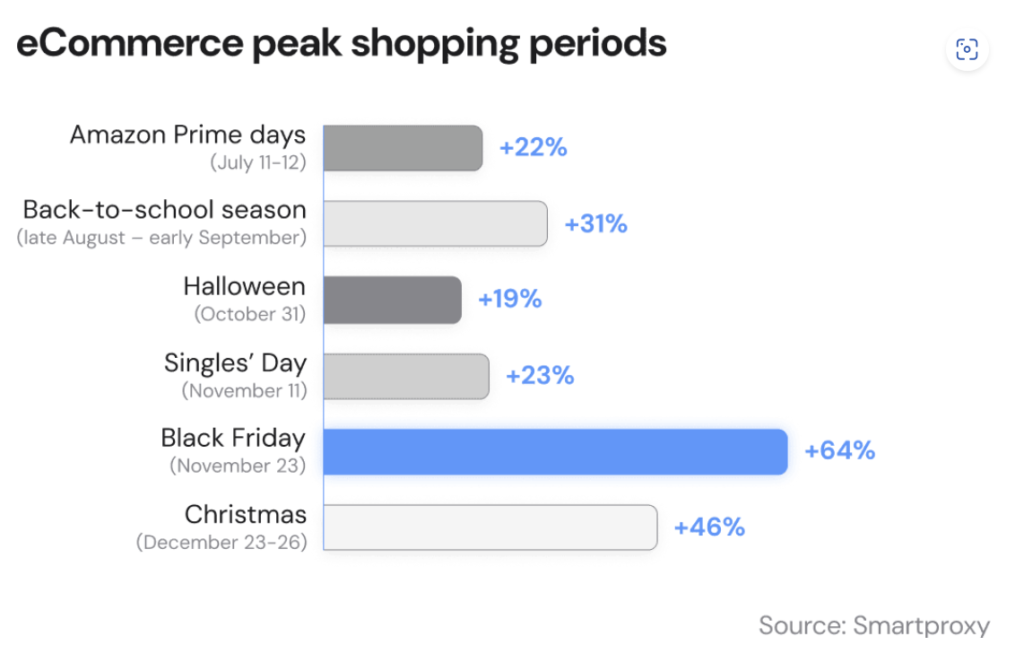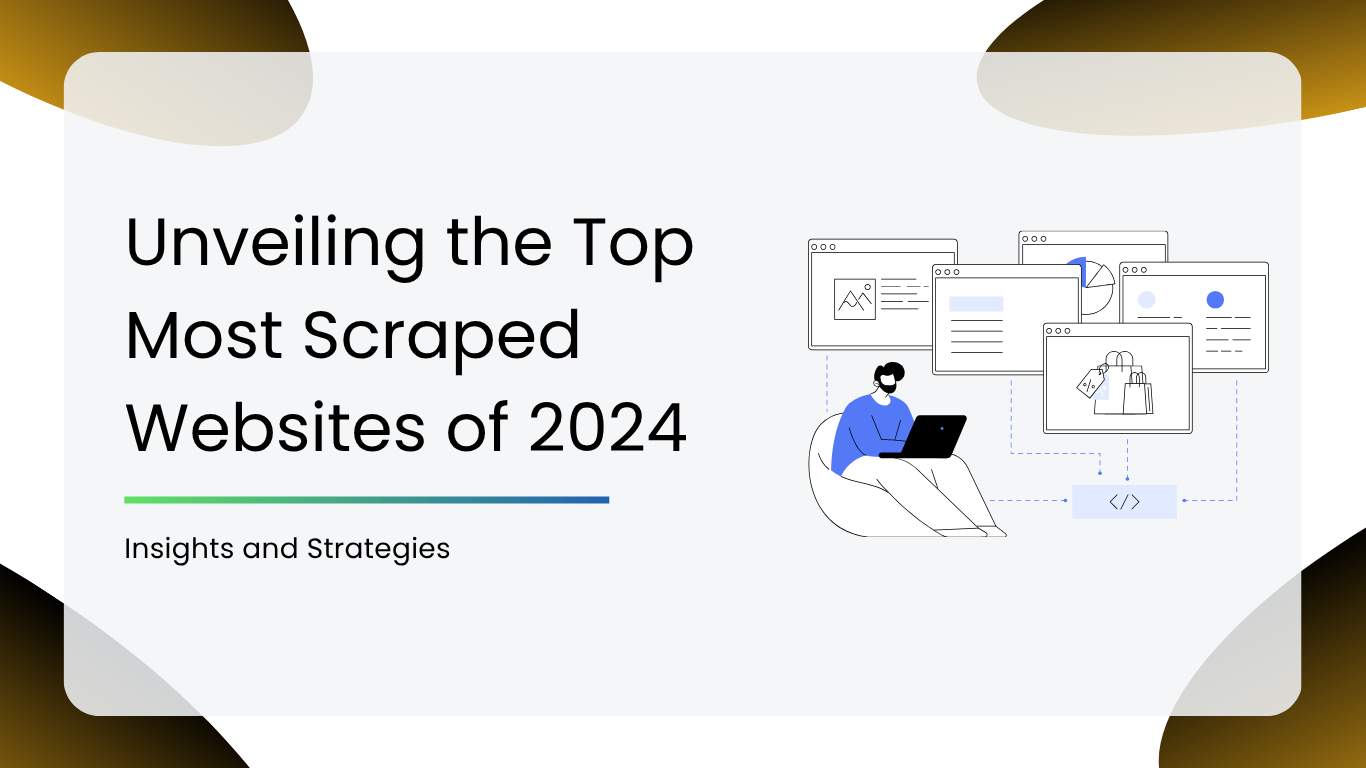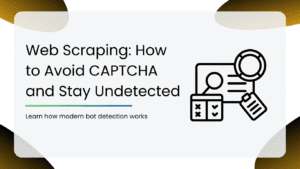Discover how businesses can harness the power of web scraping to stay ahead in competitive markets!
In today’s fast-paced digital world, it is all about being ahead of the game to succeed. Having your hands on the latest and most reliable information available is the way to success. Web scraping is an extremely useful tool that allows companies to harvest priceless insights from a number of web sources. According to Smartproxy’s most recent blog release, “Behind the Clicks: Most Scraped Websites of 2024,” certain websites have turned into top priority targets for scrapes, thanks to the quality and relevance of the information they offer.
Brief Overview: Smartproxy, the top API scraping solution provider, has published its annual list of the top 10 most scraped websites of 2024. This report is a deep dive into the data and offers actionable insights for businesses looking to utilize web scraping for strategic gain.
This report the top 10 most scraped websites in 2024, reveals the kind of data that companies scrape and how that data offers strategic benefits. From SEO optimization to competitive intelligence, the data that can be gleaned through web scraping can revolutionize the way that businesses compete and operate in the market.
In this in-depth overview, we break down the details of why these sites are highly scraped and how various industries can use the data gleaned to optimize their strategy. Whether you are an SEO manager seeking to boost search rankings, a market research professional interested in industry information, or an eCommerce business looking to remain competitive, gaining knowledge and utilizing scraped data is key.
Join us as we explore the most important data points of these highly scraped websites, with practical applications and best practices for using this data. By the end of this guide, you’ll be well-versed in how to utilize the power of web scraping to fuel growth and innovation in your business.
Categories of most scraped websites:
| Category | Share | Use Cases | Benefits |
| Search Engines | 42% of all requests | SEO analysis, keyword research, content optimization, market trend tracking | Enhances online visibility, tailors content refines targeting strategies, maximizes ROI in low-competition search queries |
| Social Media | 27% of all requests | Brand sentiment monitoring, market trend analysis, competitor research | Gains insights into customer preferences, tracks ad campaign effectiveness, identifies communication gaps |
| eCommerce | 18% of all requests | Price comparison, market analysis, trend tracking, competitive intelligence | Optimizes pricing strategies, identifies top-selling products, analyzes peak shopping hours |
| Community Forums | 7% of all requests | Sentiment analysis, trend identification, content topic search, competitive landscape analysis | Identifies niche audiences, uncovers potential keywords for ad campaigns |
| Real Estate | 3% of all requests | Competitor listing monitoring, pricing strategy adjustment, user review analysis | Targets potential buyers and renters with precise ads |
| Other | 3% of all requests | Various niche applications not covered by the main categories | Diverse data collection for specialized needs |
Data collection trends:

Top 10 Most Scraped Websites of 2024 – Key Findings:
Website 1: Google
According to the report by Smartproxy titled “Behind the Clicks: Most Scraped Websites of 2024,” Google, with over 80% of the search engine market share according to Statista, is a primary target for scraping activities. With an average success rate of 99.98%, these services enable users to gather real-time data essential for SEO management..
Key Data Points:
Through the SERP Scraping API, users collect important information on meta titles, meta descriptions, and keywords across various Google services, improving their SEO strategies and gaining competitive insights. Here are the key data points:
- Meta Titles: Titles of web pages that appear in search results, useful for understanding competitors’ content and keyword targeting.
- Meta Descriptions: Brief descriptions under meta titles, helping optimize click-through rates by analyzing competitors’ summaries.
- Keywords: Various terms and phrases targeted by competitors, that are essential for developing effective keyword strategies.
- Search Engine Results Pages (SERPs): Rankings of websites for specific keywords, useful for competitive analysis and identifying improvement opportunities.
- Google Ads: Data on ad titles, descriptions, and keywords, providing insights into paid search strategies.
- Google Images: Visual content related to keywords, helping in understanding search trends and optimizing image SEO.
- Google Shopping: Product listings, prices, and descriptions, that are crucial for tracking pricing of the competitors and product offerings in eCommerce.
- Google Travel Hotels: Hotel listings, reviews, and prices are valuable for monitoring market trends and customer preferences in the travel industry.
- Google Suggest: Popular search queries and emerging trends are useful for content creation and SEO strategies.
How to Leverage This Data:
- For Businesses: Drive marketing and SEO efforts with insights from Google data.
- For Consumers: Make smarter buying decisions with rich data insights.
- For Market Researchers: Identify industry trends and consumer behaviour patterns with rich data.
- For Content Creators: Develop high-impact content that resonates with trending search queries.
- For SEO Managers: Optimize search engine rankings with focused keyword and competitor analysis.
- For Advertisers: Optimize ad relevance and performance with rich ad data from Google.
- For eCommerce Businesses: Remain competitive by keeping pace with and adjusting to market trends in product listings and pricing.
Website 2: Amazon
Amazon ($574B Revenue, 2023) is a prime target for scraping. Given that it is the 3rd largest company by revenue globally and ships over over 1.6M packages every day, real-time data from Amazon is invaluable for eCommerce growth!
Key Data Points:
Users obtain key data on products, sellers, and pricing on the multitude of Amazon services via the eCommerce Scraping API — allowing them to further strengthen their eCommerce strategies and insights. Here are the key data points:
- Amazon Search: Data on search results for products.
- Amazon Bestsellers: Information on top-selling products.
- Amazon Product: Detailed product listings and descriptions.
- Amazon Pricing: Pricing data for competitive analysis.
- Amazon Reviews: Customer reviews for product feedback.
- Amazon Questions: Questions and answers for additional product insights.
How to Leverage This Data:
- For Businesses: Use data from Amazon to optimize product and pricing strategies.
- For Consumers: Make better buying decisions with detailed product information.
- Market Research Professionals: Spot market trends and consumer habits.
- For Content Creators: Generate content that resonates with trending products and interests.
- SEO Managers: Increase the surface area of products with focused keyword mapping.
- For Advertisers: Enrich ad campaigns with granular product and market information.
- For eCommerce Businesses: Stay competitive by keeping a close eye on market trends and adjusting prices and offerings accordingly.
Website 3: Tripadvisor
Tripadvisor, with 30.2 million reviews as of 2024, is a valuable source of information for the travel industry. It provides real-time customer experience and preference data.
Key Data Points:
Individuals collect vast reviews and ratings of various Tripadvisor services using scraping methods, thereby enhancing their service quality and gaining valuable competitive intelligence. Here are the key data points:
- Hotel Reviews: Customer feedback on hotel stays.
- Restaurant Reviews: Reviews and ratings for dining experiences.
- Attraction Reviews: Insights into tourist attraction experiences.
How to Leverage This Data:
- For Businesses: Improve service quality and customer satisfaction by analyzing the data provided by TripAdvisor.
- For Consumers: Make better travel decisions with comprehensive review insights.
- For Market Researchers: Identify various trends in the travel and hospitality industry.
- For Content Creators: Create content that relates to travel trends and experiences.
- For SEO Managers: Strengthen travel-related content with targeted keyword analysis.
- For Advertisers: Streamline travel advertising campaigns with detailed customer feedback.
- For Travel Agencies: Stay ahead of the competition by monitoring and adjusting to market trends and customer preferences.
Website 4: Walmart
Walmart, accounting for over 25% of all online grocery sales in the US, is a major target for scraping activities. It then uses the data collected to help eCommerce businesses adapt their business strategies accordingly.
Key Data Points:
Users scrape data for products, prices, and sales trends across Walmart services to create insights for eCommerce strategies and to understand how they stack against their competitors. Here are the key data points:
- Product Listings: Detailed information on products available at Walmart.
- Pricing Data: Competitive pricing information.
- Bestselling Products: Data on items that are top-selling
- Store Locations: Information on physical store locations and stock availability.
How to Leverage this Data:
- For Businesses: Optimize product listings and pricing strategies by analyzing Walmart data.
- For Consumers: Understand what you buy with full insights into products.
- For Market Researchers: Understand market trends and consumer inclinations.
- For Content Creators: Produce content related to popular products and trends.
- For SEO Managers: Elevate product visibility through strategic keyword analysis.
- For Advertisers: Convert ad campaigns with valuable product insights and intricate market data.
- For eCommerce Businesses: Maintain a competitive edge by staying alert on market fluctuation related to pricing and product range.
Website 5: Craigslist
Craigslist, the most widely used job search and classifieds website, is heavily scraped for various data types. The data is highly valuable for use across a range of industries, such as real estate and recruitment.
Key Data Points:
By scraping, users harvest information on job listings, descriptions of properties, and classified postings from Craigslist categories, thereby limiting their business models and acquiring competitive intelligence.
- Job Postings: Information on job openings and hiring trends.
- Property Listings: Data on rental and sale properties.
- Classified Ads: Details on various items and services listed.
How to Leverage this Data:
- For Real Estate Agencies: Enhance property databases and offer a more detailed selection to clients.
- For Recruiting Agencies: Identify potential candidates and observe recruitment patterns.
- For Small Businesses: Evaluate the quality of listings and identify gaps in the market.
- For Consumers: Identify job postings and property listings that meet their requirements.
- For Market Researchers: Observe job posting and real estate listing patterns.
- For Advertisers: Reach the right audiences with data-driven advertising.
- For Content Creators: Produce content based on trending job and property listings.
Website 6: Bing
Bing is a major scraping target with over 1.2B monthly visitors. This data, like Google, is useful information for different digital strategies.
By leveraging the SERP Scraping API, users receive valuable data about meta titles, meta descriptions, and keywords for multiple Bing products allowing them to effectively boost their SEO efforts and gather insights into their competitors. Here are the key data points:
Key Data Points:
- Meta Titles: Titles of web pages in search results.
- Meta Descriptions: Brief descriptions under meta titles.
- Keywords: Terms and phrases targeted by competitors.
- SERPs: Rankings of websites for specific keywords.
- Local Business Listings: Information on local businesses.
How to Leverage this Data:
- For Businesses: Leverage Bing data to refine your SEO and marketing strategies, ensuring your campaigns are data-driven and highly effective.
- For Consumers: Gain access to detailed search insights to make smarter, well-informed decisions tailored to your needs.
- For Market Researchers: Uncover valuable industry trends and consumer behaviour patterns to stay ahead of the curve.
- For Content Creators: Craft impactful content that resonates with your audience by aligning with trending search terms and topics.
- For SEO Managers: Boost your website’s search engine rankings with precise keyword analysis and competitor insights.
- For Advertisers: Maximize ad performance and relevance by leveraging detailed ad data from Bing to target the right audience.
- For Local Businesses: Enhance your local SEO efforts to attract more customers and grow your community presence.
Website 7: eBay
eBay, boasting a whopping 135 million users worldwide, is a top web scraping destination. The varied products available on the site provide useful information for global eCommerce companies.
Key Data Points:
Scraping consumers collect product listings, prices, and sales information from eBay websites, thus improving their eCommerce model and gaining competitive insights. Here are the key data points:
- Product Listings: Detailed information on products available on eBay.
- Pricing Data: Competitive pricing information.
- Sales Data: Data on transaction volumes and sales trends.
- User Reviews: Customer feedback on products and sellers.
How to Leverage This Data:
- For Businesses: Streamline product listings and pricing strategies through eBay insights.
- For Consumers: Make well-informed buying decisions with detailed product information.
- For Market Researchers: Find out market trends and consumer behaviours.
- For Content Creators: Create content around trending products and keywords.
- For SEO Managers: Drive product visibility through targeted keyword research.
- For Advertisers: Make ad campaigns more effective with detailed product and market information.
- For eCommerce Businesses: Stay competitive by monitoring and adjusting to market trends in pricing and product lines.
Website 8: Shopify
Shopify, which has more than 4.5M online stores, is a prime target for scraping. This data enables businesses to understand trends and enhance their approach.
Key Data Points:
Users scrape data from various stores to get details about product listings, pricing, and sales trends on different Shopify stores to optimize their eCommerce strategies and get competitive intelligence. Here are the key data points:
- Product Listings: Detailed information on products available in Shopify stores.
- Pricing Data: Competitive pricing information.
- Sales Data: Data on transaction volumes and sales trends.
- Best-selling Products: Insights into popular products and categories.
How to Leverage this Data:
- For Businesses: Improve product listings and pricing strategies by evaluating Shopify data.
- For Consumers: Make informed and better purchasing decisions with thorough product insights.
- For Market Researchers: Determine market trends and consumer preferences.
- For Content Creators: Create content that matches popular products and trends.
- For SEO Managers: Improve product visibility with targeted keyword analysis.
- For Advertisers: Enrich ad campaigns with detailed product and market data.
- For eCommerce Businesses: Stay ahead in the game by monitoring and adjusting to market trends in pricing and product offerings.
Website 9: Lazada
Lazada, serving over 560M customers, is a major target for web scraping activities in Southeast Asia. The platform’s broad product range provides valuable data for eCommerce businesses.
Key Data Points:
Through scraping, users gather product listings, pricing, and sales trends data from different Lazada categories to improve their eCommerce strategies and acquire competitive knowledge. Here are the key data points:
- Product Listings: Detailed information on products available on Lazada.
- Pricing Data: Competitive pricing information.
- Sales Data: Data on transaction volumes and sales trends.
- Best-selling Products: Insights into popular products and categories.
How to Leverage this Data:
- For Businesses: Optimize product listings and pricing strategies by analyzing Lazada data.
- For Consumers: Make informed purchasing decisions with in-depth product insights.
- For Market Researchers: Gather the complexity of market trends and consumer preferences.
- For Content Creators: Create content based on popular products and popular trends.
- For SEO Managers: Amplify product visibility with targeted keyword analysis.
- For Advertisers: Enhance ad campaigns with detailed product and market data.
- For eCommerce Businesses: Stay competitive by monitoring and adjusting to market trends in pricing and product offerings.
Website 10: Zillow
Zillow, a leading online real estate website, is a prime target for web scraping. The site offers in-depth information on property listings and market trends.
Key Data Points:
Via scraping, users gather data on property values, neighbourhood data, and market trends on different Zillow listings, improving their real estate plans and competitive intelligence. Here are the key data points:
- Property Listings: Detailed information on properties for sale and rent.
- Pricing Data: Competitive pricing information.
- Market Trends: Data on housing market trends and neighbourhood popularity.
- Rental Insights: Information on rental properties and prices.
How to Leverage This Data:
- For Real Estate Agencies: Analyze market trends and spot investment opportunities.
- For Consumers: Make property purchasing and renting decisions based on facts.
- For Market Researchers: Monitor housing market trends and spot in-demand neighbourhoods.
- For Content Creators: Create content around trending real estate news.
- For Advertisers: Target the right audiences with data-driven campaigns.
- For Investors: Evaluate property values and spot high-return investment opportunities.
- For Property Managers: Improve rental property management with in-depth market knowledge.
Smartproxy’s Role in Data Scraping:
Smartproxy’s advanced tools are pivotal for businesses aiming to extract and utilize data from the most scraped websites identified in the report. Here’s how Smartproxy’s offerings align with the insights and strategies shared:

Proxy Networks:
- Residential Proxies: Required for web scraping on popular sites like Google, Amazon, and eBay where avoiding detection and simulating genuine user activity is required to harvest data effectively.
- Datacenter Proxies: Most suitable for speedy and efficient web scraping from search engines and shopping websites with quick access to high volumes of data.
- Mobile Proxies: Helpful in viewing mobile-specific data and user behaviour statistics from websites like Google and social media websites.
Scraping APIs:
- SERP Scraping API: Enables the scraping of search engine result pages from Bing and Google, providing valuable data for SEO and keyword planning, as highlighted in the report.
- eCommerce Scraping API: Enables scraping of product details, prices, and reviews from Walmart, Amazon, and other top eCommerce sites, supporting the report’s focus on market research and competitive intelligence.
- Social Media Scraping API: Allows brand sentiment tracking and market trend analysis on social media platforms, complementing the analysis in the report on the utilization of social media information.
Data Collection Tools:
- Smartproxy Dashboard: Provides an easy-to-use interface for proxy control and efficiency, which is crucial for businesses needing optimization of their data scraping operations as described in the report. Unleash 35% off on all proxies today!
- Rotating Proxies: Offers continuous and covert access to data, necessary for web scraping active websites and maintaining data quality.
Web Scraping Solutions:
- Custom Scraping Solutions: Tailor-made to meet specific needs for data collection from various websites, covering the diverse applications identified in the report.
Smartproxy’s “Most Scraped Websites of 2024” report comes out with the most popular web scraping targets and their strategic usage. Based on this, companies can optimize SEO activities, enhance marketing efforts, and stay on top of the latest market trends. The insights gained from such most-scraped sites present golden opportunities for enhanced online exposure, better ad performance, and a competitive edge. Dive into the full report here and find out in-depth strategies and actionable facts. Use this knowledge to propel your business ahead and get an edge over your competitors.





